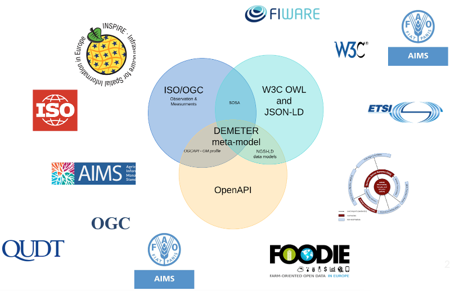
Achieving excellent project outcomes like DEMETER naturally brings questions about the solutions’ sustainability and integration into the broader ecosystem. One of the scaling factors that leverage vast adoption potential is solution accessibility for the general community. Standardisation is one of the tools that multiplicate potential, ensuring stability, lowering the cost of implementation, and avoiding vendor lock-in risk. Efforts shall be made consciously exploiting existing building blocks combined with innovations enabling advancements based on the lessons learned.
The DEMETER project implemented a comprehensive architecture covering access governance of providers and customers, data exchange and processing. Considering the potential of the standardisation we need to consider scope, available formalisation language and authorities. Thinking about scope, we select intermediary components enabling distributed services integration and how they are formally defined. Harmonising the language that we use to describe the digital distributed ecosystem components, we distinguish data and components levels. Data models, together with vocabularies, explain how the information is organised and how it relates to the described phenomena. Catalogues enable service and data exploration, finding the suitable component, and initial binding on the technical and contractual level.
Other projects like ATLAS focused on service cataloguing based on templates that, in practice, implement service descriptions and information models. CYBELE catalogued the agriculture data sets on top of the typical inventory models. DEMETER’s unique added value element is the Agriculture Information Model (AIM). The strong point of it is the added value to other widely known standards, including generic technical, domain-specific and publicly endorsed. Therefore, tools built around the underlying ontologies can support the model from the start.

Figure 1. DEMETER Agriculture Information Model as the missing component in the space of well-known ontologies
On the other hand, the semantic web is still an emerging concept if we consider general adoption among community and software development kits. To increase the chance that semantics will become widely used, it needs to be wisely built into the mainstream trends lowering the learning curve. That, consequently, brings the need to align the standardisation with other working groups. In doing so, we have focused on the three communities: IT services in agriculture and on the whole, standardisation organisations and industry hubs concentrated around data spaces.
Within the close collaboration with OGC Agriculture Domain Working Group and SmartAgriHubs, AIM was presented and discussed with domain experts in various sessions dedicated to semantic interoperability. It brought important questions about applicability: how to map own data into AIM, how successful automated binding is and about general adoption of the model within the partners. The discussion also emphasised the need to bring the AIM to the level the wider community can incorporate. The direction is in line with the modular character of the model, which can be tailored using existing and new profiles. It is also supported by the JSON-LD APIs developed within the project. At the same time, there is still a place for best practices on how to integrate it into the API standards and propose a minimum entry threshold. Alignment with the W3C recommendations, not to mention de facto standards like OpenAPI and de-jure ones like OGC APIs suite, shall be another angle of standardisation.
Considering the DEMETER results in the data spaces industry initiatives like IDS and GAIA-X, deepened discussion occurred during the formalised comparison of the sector approaches under the OpenDEI project. Agriculture data platforms from ATLAS, IoF2020 and DEMETER were brought together to understand overlaps, lessons learned and complementarity of the results. The results are going to be published in the upcoming months, but already we recognise semantics and contextualisation viewpoint analysis supports the conclusion AIM is a unique element that can enable traversal connection between data of various ecosystems and services.
As mentioned, links between semantic and technical interoperability are bidirectional. The linked data approach supported by ontologies shall be embedded in the technical definitions, while formalised ontological system description already embraces technical dimensions in the industry data spaces. Challenges of the integration were discovered under the OGC proof of concept integration of AIM with conformance criteria on the shared Definition Server. Outcomes were presented at the European Geoinformatics Union General Assembly (EGU22), where advances of the core DEMETER model and its usability for system discoverability and mediation was presented. The effort is continued in several points, including wider integration between models and advanced toolset supporting formal validation services.
Current activities of the standardisation task concentrate on the formalisation part of the cycle (figure.2). At the moment, the team is working on the Standard Working Group Charter document under the OGC Agriculture Domain Working Group. The charter will precisely define the scope of the activity, the timeline and the governance. At this stage, significant decisions shall be made about the value proposition, structure and modularity of the potential standard. Next will be consultation with to-be-liaised activities like the Geosemantics group, Architectural Board and Naming Authority and OGC/W3C Spatial data on the web Best Practices Working Group. At the same time, the standardisation activities are being aligned with the implementation of the data spaces that are re-using AIM elements to exploit digital agriculture and cross domain emerging tools.

Figure 2. OGC Innovation – Standardisation cycle


